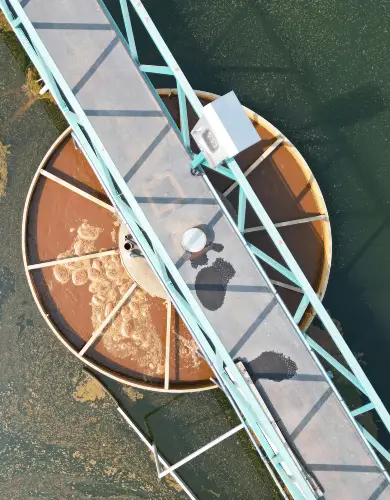Energy efficiency tips for businesses
In today’s business landscape, energy efficiency isn’t just an environmental responsibility, it’s a strategic move to significantly reduce costs.
This article unveils five low-cost, high-impact tips designed to reduce your gas and electricity consumption. We’ve backed each recommendation with facts and figures from scientific research to demonstrate the savings you can expect.
Each of our tips will result in lower business energy bills, but we’ve also included the compromises and costs required to implement each.
Our five business energy efficiency tips are:
- Reduce boiler flow temperature
- Improve building insulation
- Reduce thermostat temperature
- Upgrading lighting fixtures for LEDs
- Upgrading to a heat pump
Boiler flow temperature
Most commercial properties in the UK still use a combi condensing gas boiler for heating water used in central heating systems. A simple change in the boiler flow temperature setting presents the first opportunity to make significant efficiency improvements in gas consumption.
The boiler flow temperature is the temperature at which your boiler heats up water before pumping it along to radiators.
A study by the University of Salford found that lowering boiler flow temperature from 70℃ to 60℃ results in a 7% reduction in gas consumption, primarily attributed to increased boiler efficiency.
💡The boiler flow temperature can be adjusted on the digital display of most modern boilers.
Note that at 60℃, your boiler will still be able to heat your rooms to the desired temperature set by your thermostat. The only change is that it will take slightly longer to heat up when you first turn the heating on.
A 60-degree boiler flow temperature is recommended for well-insulated commercial buildings, while higher flow temperatures may be required for poorly insulated properties.
Building insulation improvements
The amount of energy required to retain heat inside a commercial building on a winter’s day is determined by the quality of its insulation. In buildings with poor insulation, more energy is wasted because heating systems constantly compensate for the escaping heat.
Most commercial buildings are assessed with an Energy Performance Certificate (EPC), which rates the thermal transmittance of external walls and roofs. These ratings range from “very good” to “very poor”.
An EPC assessment provides a useful indicator of your property’s efficiency in retaining heat.
For properties rated ‘poor’ or worse, low-cost insulation improvements can significantly reduce heat loss through walls and ceilings. Here are some examples:
- Fibre-glass insulation – A glass wool insulating material placed between rafters, joists, blocks, and studs that traps air, thereby slowing the transfer of heat.
- EPS bead insulation – Small polystyrene balls blown into wall cavities, also slowing the transfer of heat through walls.
- Eliminating draughts – Identifying and sealing points in your property where warm air escapes, including around water pipework.
- Double glazing – Double-glazed glass features a vacuum or gas-filled space between the glass layers to reduce heat transfer.
Quantifying the precise impact of insulation improvements on energy efficiency can be challenging, as it greatly depends on the construction and age of your commercial building.
Should your EPC certificate indicate poor insulation, we recommend consulting with a local contractor to evaluate the potential for additional insulation improvements. Investing in low-cost insulation can swiftly result in savings on business gas rates.
Heating flexibility
Our next tip involves reducing office temperatures on cold days. It is the easiest fix to implement but also one that needs to be carefully considered in the context of workforce well-being.
A thermostat controls the heating system to maintain a specific room temperature. Lowering the thermostat, even by a single degree, means the heating system will do less work and consume less energy.
The savings associated with a lower room temperature depend on factors such as the external temperature, the thermal efficiency of the building, and the size of your commercial property.
A team at UCL’s Bartlett School of Environment, Energy and Resources analysed the smart meter data of 13,000 British homes to take a real measurement of cost savings associated with simply turning the thermostat down.
The study found that each single-degree decrease in thermostat temperature between 22°C and 18°C resulted in a 5% reduction in overall dual-fuel energy bills. It’s reasonable to assume that a similar efficiency saving could be achieved in the context of small business energy.
The government provides specific guidelines for workplace temperatures, suggesting a minimum temperature of 16°C. However, this temperature may be uncomfortable for many office-based employees.
Lowering the workplace temperature to reduce energy bills is effective but should be balanced against staff preferences.
Upgrading to LED lighting
Lighting technology has evolved significantly over the past few years, notably with the advent of highly efficient LED light bulbs.
Despite this, many businesses continue to simply replace older incandescent or halogen light bulbs instead of upgrading their lighting fixtures.
💡An incandescent light bulb operates by heating a small wire until it glows. It was widely used until 2009 when these bulbs began to be phased out in favour of LEDs.
To demonstrate the energy efficiency savings of LEDs, our research team have compared the lighting performance of different bulbs required to light a ten-person office (35,000 lumens, according to Alcon Lighting).
| Lighting type | Wattage/bulb | Lumens/bulb | Bulb lifetime | Bulb total purchase costs | Annual electricity usage (kWh) | Annual electricity cost (£) |
|---|---|---|---|---|---|---|
| 75 LED bulbs | 2.2 | 470 | 5 Years | £525 | 686 | £185 |
| 22 LED tubes | 12 | 1600 | 5 Years | £396 | 1,098 | £297 |
| 100 LED reflector bulbs | 4.3 | 350 | 3 Years | £400 | 1,789 | £483 |
| 44 Halogen bulbs | 45 | 800 | 1 Year | £440 | 8,237 | £2,224 |
| 44 incandescent bulbs | 60 | 800 | 1 Year | £220 | 10,982 | £2,965 |
Assumptions: Annual electricity usage assumes the bulbs are working 8 hours a day during the normal working week. The average electricity cost is based on the 2023 average business electricity rates offered by commercial energy suppliers.
Sources: Bulb performance data extracted from lights.co.uk
LED light bulbs use up to 90% less electricity and have a lifespan that is five times longer than traditional bulbs. In most cases, it makes economic sense to upgrade your lighting fixtures to benefit from the reduced electricity costs associated with LEDs.
Upgrading to a heat pump
Heat pumps are an essential element of the UK’s transition to net zero, offering a carbon-neutral way to heat properties. They are three times more energy-efficient than gas boilers.
However, a significant barrier is the cost; only 1% of UK properties have a heat pump due to the expense, with a basic air source heat pump needed for a home-sized property costing around ten thousand pounds.
💡Heat pumps are generally only suitable for well-insulated commercial buildings and typically require the installation of more or larger radiators due to a lower flow temperature.
The table below compares the heating costs for a ten-person office on a winter day between a gas boiler, standalone electric heaters, and an air-source heat pump.
| Commercial heating options | Upfront costs | Fuel | Price of fuel/kWh | Efficiency | Daily office heating energy used (kWh) | Daily fuel cost |
|---|---|---|---|---|---|---|
| Combi Gas Boiler | £1,549 | Gas | 9p/kWh | 95% | 51 | 4.55 |
| 4x 2kW Electric radiators | £1,476 | Electricity | 27p/kWh | 99% | 48 | 13.09 |
| Air source heat pump | £10,000 | Electricity | 27p/kWh | 300% | 16 | 4.32 |
The air source heat pump is by far the most energy-efficient heating system. However, this efficiency only translates to minimal cost savings at present due to the comparatively high electricity prices in the UK.
However, the other cost benefit is that it may let your business become gas-independent, letting you avoid paying the daily business energy standing charge to business gas suppliers.
In certain regions, the significant upfront investment required for a heat pump can be offset by generous grants. For more information, check out our business energy grants page.
💡Ground-source heat pumps are another option for larger commercial buildings but require a substantial investment, including excavating a borehole.
Improving business energy efficiency with AquaSwitch
We hope you’ve found this guide useful, offering actionable advice on how to improve the energy efficiency of your business on a small budget.
In researching this article, our writers noticed that a lot of energy efficiency advice, including the government’s energy efficiency campaign, provides only vague references to expected savings. We’ve endeavoured to attach some real-world figures to all our advice.
In addition to this guide, here are some other ways we help UK companies get more energy efficient:
- Business energy audit – An in-depth guide and checklist for larger businesses to analyse the energy efficiency of plant and equipment.
- Renewable business energy – A guide on how businesses can reduce energy costs and go green by generating their own renewable energy.
- Business energy comparison – Get a better deal on unavoidable business energy costs with our easy comparison service.
- Business gas comparison – Given the expense of upgrading to a heat pump, a paid gas supply is necessary for many small businesses. Find savings with our comparison service.
- Business energy monitors – Use a smart meter or half-hourly meter to record and analyse your business energy consumption.

